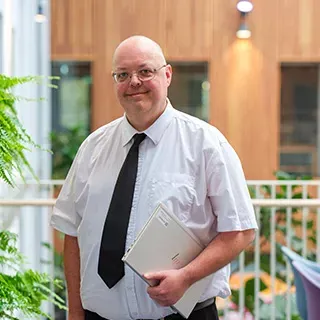Nick Tomlinson
Published: Tue 10 Jan 2023
Published: Tue 10 Jan 2023
Nick Tomlinson MIET CEng, is a Principal Electrical Engineer at Sweco UK. The work is varied, which as Nick says; “Makes for interesting times and keeps the mind active”.
Currently, he’s consulting on a water company’s storm spill program, validating the electrical, instrumentation, control and automation design throughout the different stages of the project.
“It feels like I work at two companies,” he laughs, “but this gives me a great opportunity to expand my horizons, network and feel a sense of fulfilment from all angles.”

Nick was inspired to become an engineer in part thanks to his grandad, who taught him about his tools and mechanics. His interest then spread into taking things apart in order to see how they worked.
“This engineering mindset developed as part of my personality. Even now my hobbies involve engineering – I’ve completed vocational City & Guilds courses on heat pump installation and pipework brazing, and I’m the Technical Director at a classic car club. I may already be an engineer, but that doesn’t stop me continuing to learn.”
Nick went on to complete a master’s degree at university, before starting a career in instrumentation and control automation. Later he moved into motor control centre (MCC) manufacturing and electrical, as well as control network communications.
As his career progressed, he became more involved in the commercial side of engineering, where he began managing teams and projects.
Nick was introduced to the IET many years ago through a presentation at work. He found the idea of membership interesting as a way to access further learning and enhance his career. He also noted that the projects he was working on aligned with the requirements of Chartered Engineer (CEng).
It was during his time working at Yorkshire Water that he began his journey towards Professional Registration, after his initial meeting with a Professional Registration Advisor (PRA).
“It was after getting to know my PRA David Hoyle, and his history of mentoring others, that I saw his career path aligned with my own and my personal aims. Becoming Chartered gives a formal indication of development, knowledge and experience not only from a technical perspective, but also from commercial and managerial experience.
“He had an impact on me, but I also had encouragement from others who were already Chartered Engineer status or Fellows of the IET in their field, who noted that I had the experience to apply. So, I threw myself into it, as CEng would open doors to actively being able to mentor others formally, rather than informally, as I had done in the past.”
As a PRA, David provided instrumental support and guidance to Nick during his CEng application, which included proofreading his application and providing feedback on where he had aligned his experience to the UK Standard for Professional Engineering Competence (UK-SPEC).
Nick also took advantage of the IET’s previous Career Manager system. This was perfectly functional, he says, but in his own words, the latest version of the software is “far superior”.
“I wish I’d had the opportunity to use Career Manager in its current form when I applied for Chartership – it’s a well thought out design to support the application process. The CPD recording is excellent and gives a record of what experience you have so far, plus an opportunity to add a reflection on that experience.
“Recording your experience in a spreadsheet by yourself wouldn’t give you this thought process,” he notes.
Becoming Chartered was a way of showcasing Nick’s knowledge in both a formal and informal way. His current role recognises his Chartership and has given him advanced metrics on his personal experience profile.
“It opened the opportunity to be personally requested for my current secondment, and has also enabled me to become a formally recognised mentor.”
In this role Nick continues to engage with Career Manager, actively encouraging the people he mentors to use the system to develop their career and roadmap their own Incorporated Engineer or Chartered Engineer application process.
He also learnt how to make the most of the system thanks to an IET-run workshop held at the office, which provided; “a rounded guide on how to use Career Manager for people who want to apply for Professional Registration,” he says. “The Q&A session also gave mentors like myself an insight into the review process, in order to better support colleagues with the application.”
Following in the footsteps of his PRA David, Nick wants to become even more involved in aiding his peers, so he can share his experience to “continue the cycle of engineering recognition”. He has now completed his application to become an IET Fellow, and in time aims to become a PRA supporting others applying for Charter- and Fellowship.
Nick’s main advice to others considering Professional Registration is simple – don’t delay.
“Like starting a pension or planting a tree, the time is now. I say this because if I could do my time again, I would have built my career in a ‘bitesize’ format, using Career Manager as the tool of choice to do this.
“Instead, I had to review my career from my historical archive notes to create my application. I’m sure that the application process would have taken a quarter of the time if I’d used Career Manager from the get go to record my experience and Continued Professional Development (CPD).”
Thanks for your patience. We’ve upgraded our systems, all part of our big picture plan to deliver a great experience for you.
Your log-in access has been reinstated for our websites and systems but should you encounter any issues, our Member Relations team is here to support you on +44 (0)1438 765678 or via membership@theiet.org.